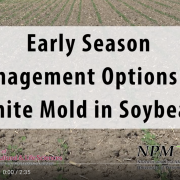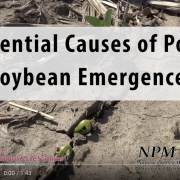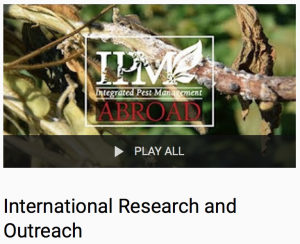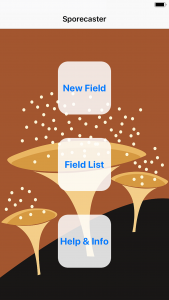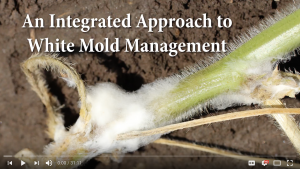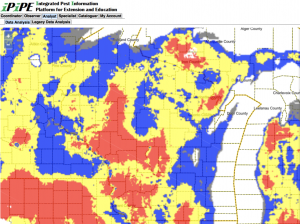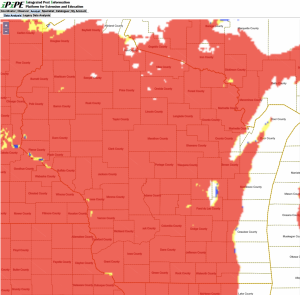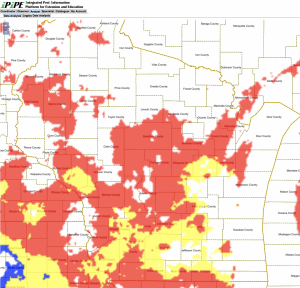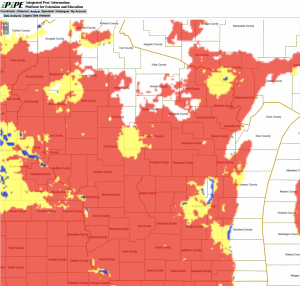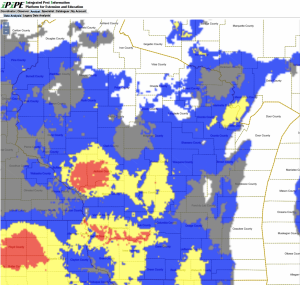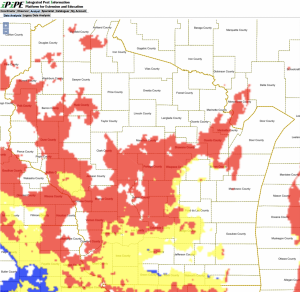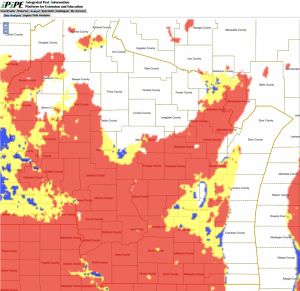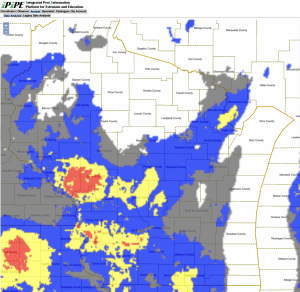Damon L. Smith, Extension Field Crops Pathologist, University of Wisconsin-Madison
Jaime Willbur, Graduate Research Assistant, University of Wisconsin-Madison
Sclero-cast: A Soybean White Mold Prediction Model
**This tool is for guidance only and should be used with other sources of information and professional advice when determining risk of white mold development. We encourage you to read the model how-to guide which can be downloaded by clicking here**
Risk of apothecial presence and subsequent white mold development has increased over the past week in non-irrigated fields (Fig. 1). Cool temperatures and high moisture have increased risk to high levels especially along the southern tier of counties, and into Dodge and Fond du Lac counties. Risk remains high in west-central to northwest portions of Wisconsin and in a band stretching from south-central Wisconsin to northeast Wisconsin.
Areas of high risk have remained steady in irrigated soybeans planted to 15-inch rows (Fig. 2) and 30-inch rows (Fig. 3). Soybeans planted to 15-inch rows and irrigated are under high risk for white mold development in the southern region west-central region and in a band stretching from central to northeast Wisconsin. Risk in irrigated soybeans planted to 30-inch row spacing remains low to moderate.
The Field Crops Pathology crew has also started scouting commercial fields, and research plots, for apothecia. Consistent with the models, we have found apothecia under irrigation on the central sands. We did not find apothecia in dryland environments in the southern tier of the state, where there was low-to-moderate risk expected.
I expect risk to continue to remain steady over the next week, as heat will be accompanied by frequent rain events. Continue to growth-stage soybeans and note that map predictions should be considered for making white mold management decisions if soybeans are flowering AND soybean canopies are nearly closed. For more information on white mold and white mold management, see this previous post.
 Figure 1. Apothecial Risk for non-irrigated soybean fields (July 17, 2017) |
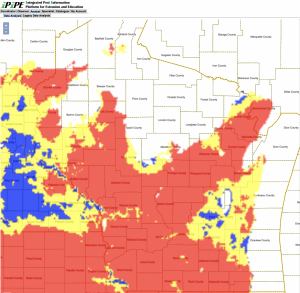 Figure 2. Apothecial Risk for soybeans planted to 15″ rows, under irrigation (July 17, 2017) |
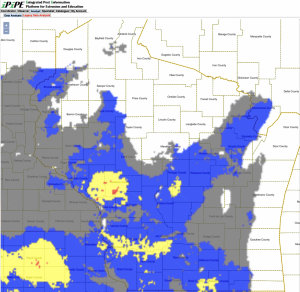 Figure 3. Apothecial Risk for soybeans planted to 30″ rows, under irrigation (July 17, 2017) |
|
Map Legend: White = model is inactive and risk of apothecia in the field is likely low; Gray = apothecia might be present, but likelihood of apothecial presence is less than 5%; Blue = low risk of apothecia in the field (5 to <15% chance); Yellow = moderate risk of apothecia in the field (15 to <30% chance); Red = high risk of apothecia in the field (30% or higher chance). Model predictions must be combined with soybean growth stage and canopy characteristics to aid in timing of fungicide sprays.
These models were developed at the University of Wisconsin-Madison in conjunction with Michigan State University and Iowa State University to identify at-risk regions which have been experiencing weather favorable for the development of white mold fungus apothecia. Weather information and maps are provided by the Soybean Integrated Pest Information Platform for Extension and Education (iPIPE), which is managed by ZedX, Inc. This model predicts when apothecia will be present in the field using combinations of 30-day averages of maximum temperature, relative humidity, and maximum wind speed. Using virtually available weather data, predictions can be made in most soybean growing regions. Based on these predictions, a map is generated under three scenarios (non-irrigated soybeans, soybeans planted on 15″ row-spacing and irrigated, or soybeans planted on 30″ row-spacing and irrigated). The maps are colored to show the likelihood of apothecial presence within a region. If the model is predicting high risk (red) in your area for your planting scenario, the soybeans are flowering, and the canopy is somewhat closed, then the white mold risk is elevated. If your fields are at-risk, we recommend to consult your local extension personnel or resources for the best in-season management options for your area For further information on how to use and interpret these risk maps, CLICK HERE to download a how-to guide.
 In this video I visit a soybean field to talk about white mold, row spacing, planting population and the new Sporecaster white mold management smartphone app. in an effort to develop an integrated management strategy for white mold control.
In this video I visit a soybean field to talk about white mold, row spacing, planting population and the new Sporecaster white mold management smartphone app. in an effort to develop an integrated management strategy for white mold control.
